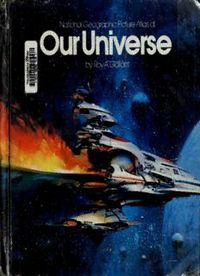
National Geographic picture atlas of our universe PDF
Preview National Geographic picture atlas of our universe
National Geographic PiotHre Atlas of K ?^ by RoyA"GaIldiint m .. '• /: 4r,. k>^ ' Mr 'i- I ^ -iU ^ .^:. /^Wm' K - '. ;>^'. •/^** ^•^ti. ^ i ^.» i -v.. \ ft--^"- t Naylor Media Center • 3 0525 0003G 7839 W: 523 ^'O/US-3 /%^ ^^ Ga Gallant, Roy c.3r OUR UNIVERSE .i' I DATE DUE ^ ^ 2? t' 191 NW-1 R«2 u J^ ^URSi 032 AlhlAMii seM-+ J_J3^ 2 m) -0:^ 3EP2 OCT 0. 1 1989 '«R*V'M«i ;i' f "J^rf 1SW»*--'^ 'W'LOR Minn I c" c^i jooj ' 'RRAW. /i«^ •i^lS % %. National Geographic Picture Atlas of by RoyAGallant OurUniverse T SPouhcbeileiNtsayhteiodnbaly Geographic CMRheoalbiveirnmtaMnE.ofPDtoahyelneBeoard EGMdieiltvboierlrltEemMeB.reilGtlursGorsovsevneonror CDPNiahrrtaeeirpcoltanoerarseldOG.beyoHgyrmaaphnic Book Service President Editor Kenneth C. Danforth Owen R. Anderson Managing Editor Secretary A IlnlunsetraDtiornkseEsdiKtorbor Staff for this bool< EMdairtgoraret Sedeen MaelrayniB.e DAincnkiCnosronner JEnoghrnavTi.ngDuandn Printing ADratvDiidreMc.torSeager SMRhe.isrWelaersychhLb.uSrcnotStwain JV CiohrahgrnilneiDa.s LGW.a.rBsBatez,rarJry. Constance Brown Boltz Editorial Contributions by Gary M. Johnson - , Associate Art Director Wendy W. Cortesi MarkSeidler PLicntduareBE.diMteoyrerriecks SUuszeaSnwniensP.onKane AGleforgerdapL.hiZcebAratrth REleiszeaabrecthhELd.itNorewhouse ARonbneertWiCt.heFrisrestone iGnedoerxge I. Burneston III S DRaeovsyismdoSuF..rBReLo.nbnFieintssthobnein PAKrsaosridesutncatniFt.onPErMdoadwunacartgdieosrn Manager ACRrootnntCroiMnbisulutllietorantsiobny and Jonathan B. Tourtellot Richard S. Wain Planet views and landscapes by Editor-Writers Production Assistant Ludek Pesek Paulette L. Claus Planet maps by Editorial Assistant Jay L. Inge Scientific Consultants AMmaerrkicRa.nCMhuasreturamn-dHaIIyIden HOawrevanrdG-iSnmgietrhisocnhian Center SGtoeddpahredn SPp.aMcaerFalnight Center Planetarium for Astrophysics J N.ADSaAvid Bohlin NaoteilonWal.AHirinanedrSspace Museum PEdeutceartiLo.nMalunCornoseultant Geoffrey A. Briggs Henning W. Leidecker NASA ' Dept. of Physics, The American University C Socpiyertiyg,htWacs;h1i9n8g0toNna,tiDo.naCl. GAlelorgirgahtpshic FLirbsrtareydiotfioCno6n7g0r,e0s0s0CcIoPpideast.a page 276. reserved. Reproductions of the whole or 338 paintings, drawings, phonographs, any part of the contents without written and maps. permission is prohibited. Contents foreword by Michael Collins 6 Sun Gods to Gamma Ravs Beginnings 9 Our Solar System Home The Sun & Planets 37 The Star We Know Best The Sur. ^9 The Swittest Planet Mercury (b9 A Veiled Planet VenuL 81 The Planet We Know Best Earth c?3 The Red Planet Mars i;25 A Planet That Never Was Asteroids & Meteors u« King of the Planets Jupite- 1^53 The Planet with Ears Saturn i;'3 A World on Its Side Uranu*' li]3 Last of the Giants Neptune 1 ^ A Double Planet';' Plutc 1<;V Snowballs in Space The Comets 2C)3 To the Stars 8c Galaxies Deep Space 215 The Future Shuttles & Starships 251 space Age Highlights 264 Observing the Universe 272 Glossary 270 Index 274 Measuring the Universe 271 lllustraTions Credits 276 . -oreWorc When I was young, I used to look up into the the sound of their names excites me. More sky and see airplanes. Later, when I flew enticing still is the prospect ofwhat Voyag- those airplanes, I realized I still hadn't got- er will tell us about Saturn. We already ' r ten very high, that I couldn't go wherever I know that one of Saturn's moons. Titan, is could see. I kept trying and I did get as far surrounded by a thick atmosphere. It is my as the Moon. To Neil Armstrong, Buzz Al- favorite candidate for human exploration. drin, and me, that seemed a very long trip, Beyond Pluto, we have to admit that the but compared to reaching the nearest star distances seem to be too much for us, at it was like moving past a dozen grains of least if we regard the velocity of light as sand on a beach. The Moon is about 385,000 the universal speed limit. However, not too kilometers from Earth, while the nearest many years ago, experts believed we would star, Proxima Centauri, is 40 trillion kilo- never break the sound "barrier." Right meters away! Now, back here on Earth now, Einstein's theories seem to deny us with a better appreciation of distances, I the stars. Perhaps someday we can discover borrow the eyes of astronomers to show me how to disembody humans in one place and those places I will never visit. This beauti- recreate them elsewhere, to circumvent ful book will help you to do that. Einstein's barrier, and to roam the Uni- Throughout history, the genius of as- verse, seeking our peers or our superiors. tronomers has been their ability to let The more we see of other planets, the their minds roam to the far reaches of the better this one looks. When I traveled to Universe while their bodies were trapped the Moon, it wasn't my proximity to that on Earth. Kepler, tracing the planets in battered rockpile I remember so vividly, their orbits; Einstein, seeing the Universe but rather what I saw when I looked back emerge from his chalkboard -they have at my fragile home -a glistening, inviting freed our minds if not our bodies. beacon, delicate blue and white, a tiny And perhaps our bodies will not be far be- outpost suspended in the black infinity. hind. Rockets have propelled astronauts to Earth is to be treasured and nurtured, the Moon and fired Pioneer spacecraft com- something precious that must endure. pletely out of the Solar System. It is now The next two decades should be the most technically possible for people to visi*^ productive years astronomers have ever Mars, approximately nine months away. known. With space telescopes we will accu- The other planets are almost within our mulate more information about the Uni- grasp and the moons of Jupiter and Saturn verse than we have since humans began to may be the unrealized gems of our Solar study the heavens. May we be intelligent System. The cameras of the Voyager space- enough to comprehend it and sensible craft have transformed Jupiter's moons enough to use it to solve some of the press- from mere pinpoints of light in a telescope ing problems of our unique home. \^ into intriguing, colorful spheres. lo . . Michael Collins Europa ... Ganymede . . . Callisto. Even A spectacular night launch of Apollo 17 crowns thp mj^n series that landed 1 2 U. S. astronauts on the Moon.
